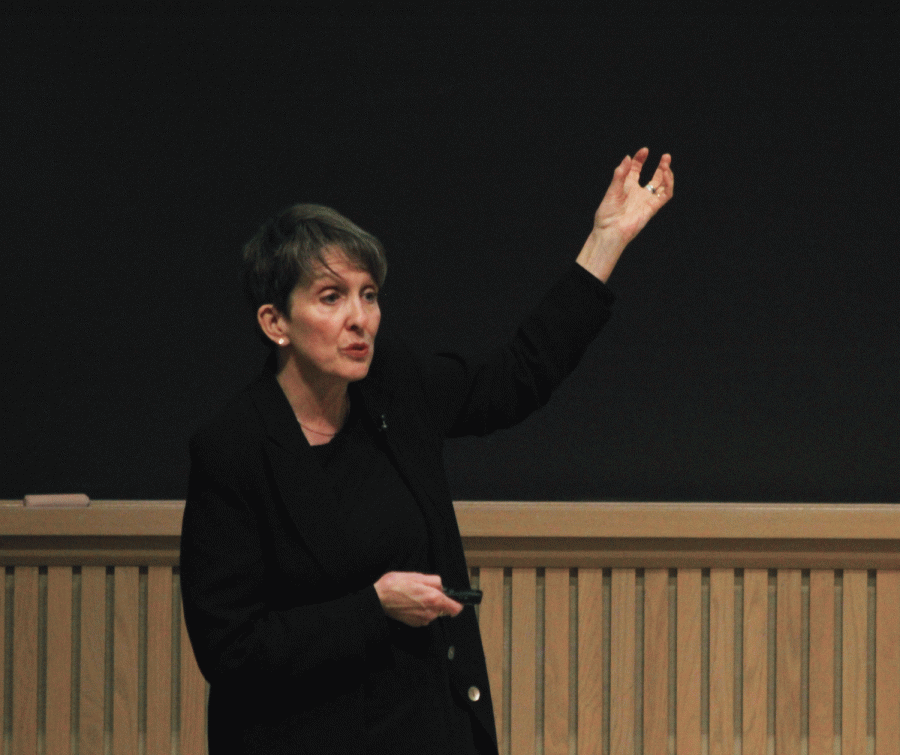Ries Defines Modern Russian Mafia Ties with United States
Professor Nancy Ries discussed the formation of the Russian mafia and traces its history from 1985 until the present day. She explained similarities between Russian and American Gangster Economies and Politics.
On Monday, November 27, Professor of Anthropology and Peace and Conflict Studies Nancy Ries spoke to students and staff in Love Auditorium about her understanding of the international connections made between the world’s mafias and her experiences when dealing with gang-members during her travels to Russia.
Ries began her talk discussing the Soviet Union from the years 1985-1991 during the time of “perestroika,” a political reformation from within the Communist Party. At this time, the Soviet Union boasted an advanced economy that flexed a GDP of 2.6 trillion USD in 1990 – the second largest in the world at the time. During reconstruction of the Communist Party under Soviet leader Gorbachev, new laws were installed into everyday life. The most notable of these additions was the Law on Cooperatives in 1988, which allowed for Soviet micro-businesses, such as cafes, computer repair shops and kiosks to develop. Often, smaller businesses would be attached to factories.
From this small-scale business boom came the concept of “shadow privatization,” where bureaucratic elite cooperated with the small businesses to gain wealth. Money made from these ventures was not taxed and did not benefit workers. It assisted only those at the top of a business model. Eventually, banks were adopted under the Law on Cooperatives. The economic collapse in 1990 only reinforced the potential power that mafias could exercise through a concept known as krysha, which means “roof” in Russian.
Gangs would offer small businesses krysha as a form of protection from other street groups.
“You tell the proprietress that she owes you five percent of what she makes today in exchange for protection. Your krysha guys protect her from the other krysha guys. It very soon evolved that you couldn’t have any business without krysha,” Ries said.
Krysha – along with privatization, hyperinflation, racketeering, money laundering, capital expropriation and assassination – helped define a period of an “Official Gangster Economy.”
“Those street gangs become much larger gangs, some of them under control from old mobsters from the Gulag. These guys make any other mafia in the world seem mild in comparison,” Ries said.
She then explained her own run-in with a man named Misha, who allowed Ries to accompany him on his daily routine. This included making deals with not only the head of a university but also local law authority. Ries also noted that although she was fluent in Russian at the time, these conversations between Misha and whichever partner he was striking a deal with were spoken entirely in slang and mafia jargon. In a way, the mafia tied the various facets of white-market dealings together through underground black-market connections.
In fact, according to Ries, many Russians constantly joke that “the real mafia is at the Kremlin.”
To the Russian people, all forms of police force and various other state-operated institutions fall under the definition of Siloviki, meaning “force personnel.” A famous Siloviki is Vladamir Putin, an ex-KGB who, prior to becoming president, was under multiple investigations for collaboration with criminal organizations and various other corrupt practices. With Putin’s presidency comes the ever-tightening grasp that both the Siloviki and mafia have over Russia, leading to what Ries dubs a “Thugocracy,” a transnational phenomenon which exhibits characteristics of “performative aggression, rhetorical violence and violation, intimidation, and threat.”
Russia’s thugocratic issue shares similarities with American politics today. President Donald Trump, a businessman with previous involvements with American mafia members such as “Joey No-Socks” Cinque, “Fat Tony” Salerno and Paul Castellano, has had his own run-ins with members of Russian mafias, such as when twenty-nine mobsters were arrested in a gambling ring run by Vadim Trincher and Anatoly Golubchik in Trump Tower in 2013.
“They were living right under Trump’s krysha, literally!” Ries said.
Ries’ presentation ended with bold speculation of potential collusion between the Russian and American thugocratic systems.
“Occasionally, the degrees of separation between [Trump and Putin] maybe number only two or three,” Ries said.
Ries also explained that many world leaders today exemplify thugocratic behavior, including Recep Erdogan of Turkey, Rodrigo Duterte of the Philippines, and Jacob Zuma of South Africa.
After Ries’ presentation, first-year Liana Escue explained her feelings on the potential existence of an underground mafia network that now occupies central governments across the globe.
“The idea of there being a series of people connected together that now control major factors of countries is absolutely terrifying,” Escue said.
First-year Nikhil Rajavasireddy also shared Escue’s thoughts.
“Well, the fact that [politicians and mafia members are] ‘business partners,’ if you can call them that, is definitely worrying. As unlikely as it is that there’s some sort of huge organization behind the world leaders, I can see why someone could come to that conclusion,” Rajavasireddy said.
Contact Miller Downer at [email protected].
Miller Downer is a senior from Natchez, Mississippi concentrating in environmental biology and English. He's previously served as an assistant commentary...







